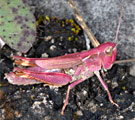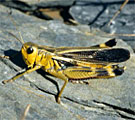Tetrix bipunctata (Linnaeus, 1758)
![Tetrix bipunctata: Adult (eastern Swabian Alb, S-Germany, April 2013) [N] Tetrix bipunctata: Adult (eastern Swabian Alb, S-Germany, April 2013) [N]](thumbs/tetrigidae/bipunctata_im2013.jpg)
![Tetrix bipunctata: Adult (eastern Swabian Alb, Germany, August 2012) [N] Tetrix bipunctata: Adult (eastern Swabian Alb, Germany, August 2012) [N]](thumbs/tetrigidae/bipunctata_i2012.jpg)
![Tetrix bipunctata: Adult (eastern Swabian Alb, Germany, August 2012) [N] Tetrix bipunctata: Adult (eastern Swabian Alb, Germany, August 2012) [N]](thumbs/tetrigidae/bipunctata_2i2012.jpg)
![Tetrix bipunctata: Adult (eastern Swabian Alb, Germany, August 2012) [N] Tetrix bipunctata: Adult (eastern Swabian Alb, Germany, August 2012) [N]](thumbs/tetrigidae/bipunctata_3i2012.jpg)
![Tetrix bipunctata: Adult (Lechtal near Forchach, Tyrol, September 2010) [N] Tetrix bipunctata: Adult (Lechtal near Forchach, Tyrol, September 2010) [N]](thumbs/tetrigidae/bipunctata_2011.jpg)
![Tetrix bipunctata: Adult (river Iller near Memmingen, April 2013) [N] Tetrix bipunctata: Adult (river Iller near Memmingen, April 2013) [N]](thumbs/tetrigidae/bipunctata_2im2013.jpg)
![Tetrix bipunctata: Adult (eastern Swabian Alb, Southern Germany) [N] Tetrix bipunctata: Adult (eastern Swabian Alb, Southern Germany) [N]](thumbs/tetrigidae/bipunctata_08.jpg)
![Tetrix bipunctata: Adult (eastern Swabian Alb, Southern Germany) [N] Tetrix bipunctata: Adult (eastern Swabian Alb, Southern Germany) [N]](thumbs/tetrigidae/bipunctata_i1.jpg)
![Tetrix bipunctata: Adult (eastern Swabian Alb, Southern Germany) [N] Tetrix bipunctata: Adult (eastern Swabian Alb, Southern Germany) [N]](thumbs/tetrigidae/bipunctata_i2.jpg)
![Tetrix bipunctata: Habitat on the Swabian Alb: gappy nutrient-poor limestone grassland at the wodland edge [N] Tetrix bipunctata: Habitat on the Swabian Alb: gappy nutrient-poor limestone grassland at the wodland edge [N]](thumbs/tetrigidae/bipunctata_h.jpg)
![Tetrix bipunctata: Habitat in a gappy limestone grassland of the eastern Swabian Alb (August 2012). Here I observed also Psophus stridulus and Stenobothrus nigromaculatus. [N] Tetrix bipunctata: Habitat in a gappy limestone grassland of the eastern Swabian Alb (August 2012). Here I observed also Psophus stridulus and Stenobothrus nigromaculatus. [N]](thumbs/tetrigidae/bipunctata_h2012.jpg)
Nutrition:
The insects feed on mosses, algae, lichens, detritus and also low growing herbs.
Habitat:
Tetrix bipunctata inhabits dry grasslands with partly open soil, especially often on marl. In addition, it also occurs on relatively dry, nutrient-poor forest clearings with sunny, open and mossy areas.
Life cycle:
Tetrix bipunctata hibernates as adult and can be found all year round. It is most common observed in autumn and spring. In the early summer, you find more larvae than adults.
Endangerment: endangered
Endangerment factors:
Tetrix bipunctata is endangered due to habitat loss (decline in grasslands with open soil) and by the darkening of the forests.
Remarks:
Sometimes another species, Tetrix kraussi, is separated from Tetrix bipunctata due to shorter hind wings.
The overall distribution of Tetrix bipunctata complex ranges from eastern France across Central and Northern Europe to China.
Tetrix bolivari | Tetrix ceperoi | Tetrix subulata | Tetrix tenuicornis | Tetrix tuerki | Tetrix undulata


